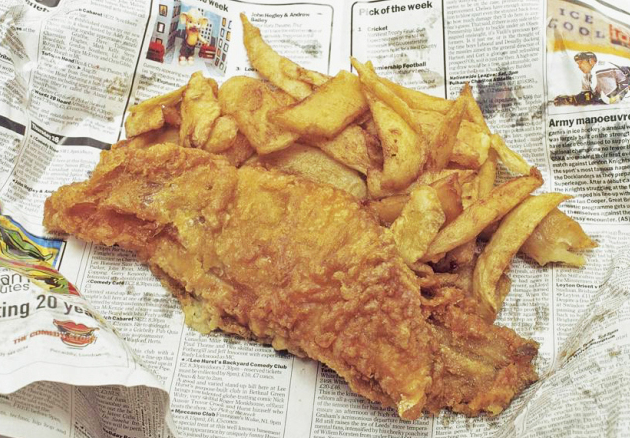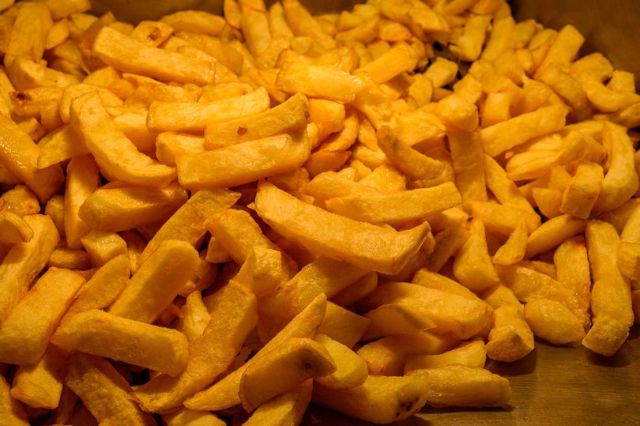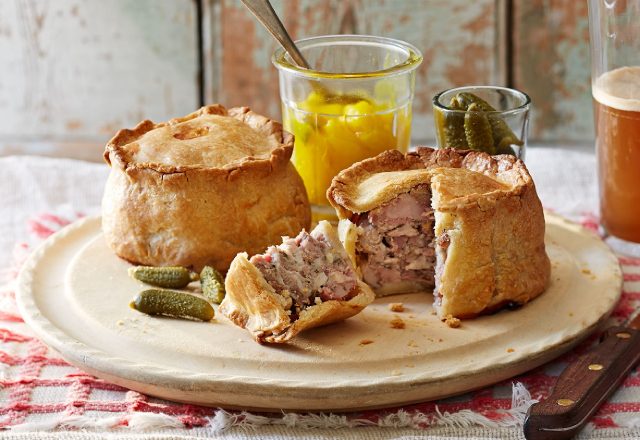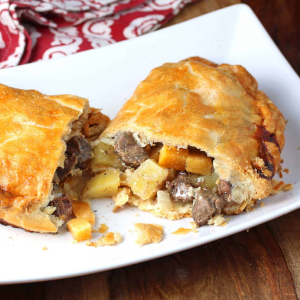You’ll probably think today’s post about UK grab-and-go eats is going to be a list of imports from other cultures. At least at first. But Britain has it’s own traditional street foods – many of which have – alas – been relegated to second place behind trendy new fusion styles…
 Classic Fish and Chips: With a drizzle of Malt Vinegar, and wrapped in yesterday’s news…
Classic Fish and Chips: With a drizzle of Malt Vinegar, and wrapped in yesterday’s news…
It’s a similar tale to that we told about New York City: You can get almost anything you want, from anywhere in the world, at some street vendor or another in London. But what we want to do is spotlight the ancient, traditional and distinctly British street foods you can still get on almost any corner.
Go back – go way back…
“Street food in Britain is not new,” a ‘brief history’ post by Sejal Sukhadwala on LoveFood notes. “The first published evidence dates back to the 11th century, when fast-food ‘cookshops’ did brisk business in London and other cities like Norwich, Leicester and York. They sold pies, flans, tarts and pasties, filled with meats like veal, goose and goat. […] In the Victorian times, popular street foods included pickled whelks, sheep’s trotters, hot pea soup and gooseberry pie.”
When researching this post, I came across many lush listings of what the authors called ‘typical’ British or London street foods: stuff like Chicken Katsu (Deep Fried Chicken in a crispy rolled tortilla – identified as a Hawaiian fave), a Pork Bao Bun, an Indian Dosa, a Bulgogi Burrito (!?), a Falafel Wrap, a BBQ Burger, a Poké Bowl… It goes on and on.
What the heck?
The first thing I asked was, “Where are the Indian (adapted to Brit tastes) items I expected to see? Butter Chicken and the other spicy ‘take-aways’ that used to be so popular?” They even earned a collective nickname: ‘Curries’. For better or worse, it appears they’ve gone legit! Some more than others, though. Several ‘dining guides’ I came across ‘looking up’ for this post listed only white-tablecloth establishments. Others, neighbourhood eateries and ‘small, casual’ joints.
In short, many early culinary imports have become mainstream.
A poignant article in The Guardian, from 2014, even that early asked, “Has Britain’s Street Food Revolution Run Out Of Road?”
“Street food has come a long way since anarchic vendors […] began popping up in car parks,” the preamble to the piece notes. “The movement may still trade on ‘realness’ and ‘authenticity’, but big business is moving it both upmarket and indoors.”
But there are still remnants of the original Brit street food scene in evidence. Maybe ‘monuments’ to the culture, would be a more apt term….
On our menu today
Chips: Big, chunky ones with crispy crusts and fluffy interiors. The real deal ones come in paper cones.

You can get lots of different condiments, now, but the traditional adornment is still a drizzle of Malt Vinegar.
Fish and Chips: Add deep-fried Cod or Haddock for THE classic British hand meal. The Malt Vinegar rule applies here, too. As does the one that states real Fish and Chips will always come wrapped in yesterday’s newspaper. The original ‘finger-licking good’ deep-fried treat.
Pork Pies: They show up in every working man’s lunch bucket at one time or another (or every time) and are one of the most beloved street foods in the UK.

They are characterized by their palm-sized form factor (like a fancy soap cake; when sold in stores, often wrapped in paper with a sticker to seal it on top). Pork is the traditional filling, but others are now available, in commercial brands. These pies are usually eaten cold.
Cornish Pasties: A close runner-up for the most iconic hand pie in the UK is the Cornish Pastie (see photo, top of page). They’re sheets of golden pastry folded over a filling of beef and vegetables – a thick stew if you will – and crimped shut by hand. Larger than the classic Pork Pie, these scrumptious nibbles are softer on the inside and may be hot or cold eaten with equal relish.
Do we need a CAMRSF movement?
Back in the 80s, the brewpub movement rolled across Britain (and other commonwealth countries where Big Beer then had a stranglehold on commercial brewing). It was essentially a tide of popular support for the democratization of brewing, to promote the ancient tradition of the independent Public House and what have since become known as craft breweries.
Do we need a Campaign for Real Street Food (CAMRSF) to revive and support of the ancient and classic traditions of British grab-and-go? Perhaps. But I wouldn’t be the least bit upset if it stopped short of bringing back whelks and sheeps’ trotters…
~ Maggie J.

